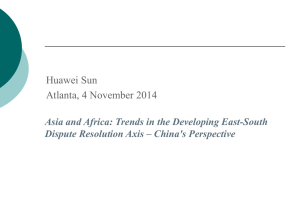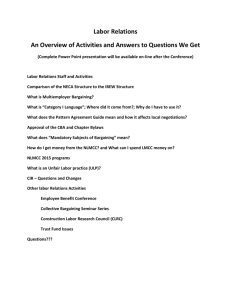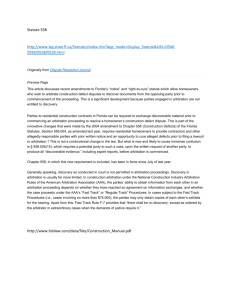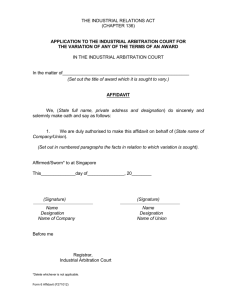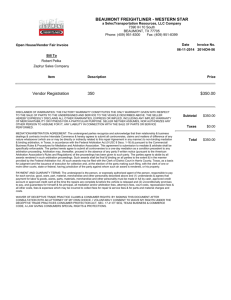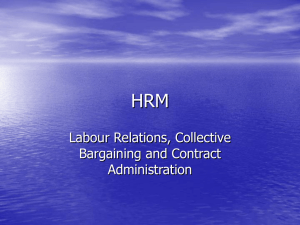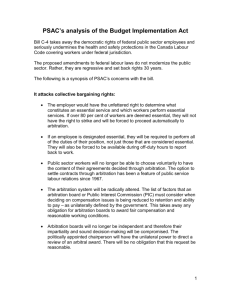Arbitration in the Collective Bargaining Context After Circuit City
advertisement
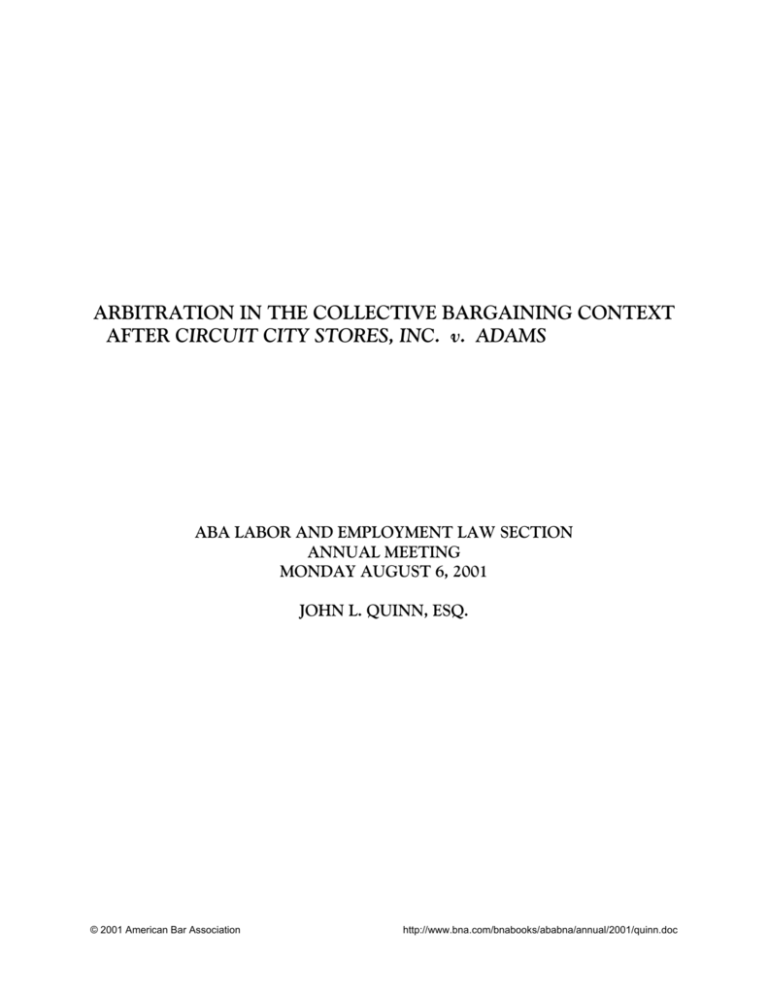
ARBITRATION IN THE COLLECTIVE BARGAINING CONTEXT AFTER CIRCUIT CITY STORES, INC. v. ADAMS ABA LABOR AND EMPLOYMENT LAW SECTION ANNUAL MEETING MONDAY AUGUST 6, 2001 JOHN L. QUINN, ESQ. © 2001 American Bar Association http://www.bna.com/bnabooks/ababna/annual/2001/quinn.doc ARBITRATION IN THE COLLECTIVE BARGAINING CONTEXT AFTER CIRCUIT CITY STORES, INC. v. ADAMS1 I. INTRODUCTION The Supreme Court=s authoritative pronouncements on interplay between arbitration in collectively bargained agreements and pursuit of individual statutory rights began with Alexander v. Gardner-Denver, 415 U.S. 36 (1974). At this time, the Court appeared to establish a firm barrier between unions= collective rights to arbitrate contractual claims and individuals= rights to pursue their statutory employment discrimination claims. The Court then provoked lively debate when it issued its decision in Gilmer v. Interstate/Johnson Lane Corp., 500 U.S. 20 (1991). In this case, the Court enforced mandatory arbitration of a statutory employment discrimination claim, based on an arbitration clause contained in an NYSE securities registration application. Two questions were left unanswered in Gilmer. The first unanswered question was whether this rule would apply in the collective bargaining context. The second unanswered question was whether the Federal Arbitration Act, 9 U.S.C. ' 1, would apply to pre-dispute arbitration procedures in employment relationships outside the collective bargaining context. In Wright v. Universal Maritime Service Corp., 1 121 S. Ct. 338 (3/21/2001). © 2001 American Bar Association http://www.bna.com/bnabooks/ababna/annual/2001/quinn.doc 525 U.S. 70 (1998), the Court flirted with an answer to the first question, e.g. the application of Gilmer in the collective bargaining context but found it unnecessary to reach this issue, holding that a general arbitration clause negotiated by a union does not create a clear and unmistakable waiver of an individual=s right to pursue statutory claims in court. This term, in Circuit City Stores, Inc. v. Adams, Justice Kennedy, writing for a five member majority of the Court, answered the second question reserved in Gilmer in the affirmative. Thus the Court read the exclusion contained in '1 of the FAA narrowly, confining its application to employment contracts for transportation workers only, insuring broad application of the FAA to all other categories of workers. The Court=s final pronouncement was: A...arbitration agreements can be enforced under the FAA without contravening the policies of congressional enactments giving employees specific protection against discrimination prohibited by federal law; as we noted in Gilmer, >[b]y agreeing to arbitrate a statutory claim, a party does not forego the substantive rights afforded by the statute; it only submits to their resolution in an arbitral, rather than a judicial forum.= 500 U.S. at 26.@2 In this arena, the focus has thus shifted from challenges to the enforceability of pre-dispute arbitration provisions to challenges to the availability of substantive rights, procedural/due process safeguards, and full remedies. 2 In recognition of the proliferation of arbitration agreements covering statutory employment discrimination disputes, the National Academy of Arbitrators, without taking a position on mandatory arbitration, adopted a ADue Process Protocol@ in an effort to ensure a more level playing field. The Protocol has been endorsed by the American Arbitration Association and the ABA. See, ABA House of Delegates Resolution No. 112 (February 1997). © 2001 American Bar Association http://www.bna.com/bnabooks/ababna/annual/2001/quinn.doc 2 What follows is a more detailed analysis of this evolution towards the arbitral construct for dispute resolution and some suggestions on what the future may hold in the collective bargaining context. II. THE BEGINNING - GILMER Crowded court dockets and the expense of traditional litigation have created substantial pressures for courts and litigants alike to find a quicker and less expensive method to resolve disputes. During the past decade, a variety of alternative dispute resolution procedures, more commonly referred to as ADR, have sprung up in many state jurisdictions.3 The Civil Justice Reform Act of 1990, requiring Federal District Courts to examine utilization of various forms of ADR.,4 added impetus to this movement. With the growing number of federal statutory provisions regulating employment discrimination, consideration of the application of ADR to such controversies understandably came to the fore. The Supreme Court=s decision in Gilmer v. Interstate/Johnson Lane Corp., 111 S.Ct. 1647 (1991), solidified the focus of attention on this issue. While this case arose on a rather unique set of facts, it provoked lively public debate and gave some guidance in the direction of ADR as a method of resolving employment disputes. The same year Gilmer 3 See AGetting off the Gravy Train: The Coming of Age of Alternative Dispute Resolution,@ The Mississippi Lawyer, Vol. XXXIX, No. 3, December, 1992 - January 1993 at 13. 4 Pub. L. 101-650, Title 1, 104 Stat. 6089. © 2001 American Bar Association http://www.bna.com/bnabooks/ababna/annual/2001/quinn.doc 3 was decided, President Bush (Bush I) signed into law the Civil Rights Act of 1991 which affirmatively recognizes that A...alternative means of dispute resolution, including ...arbitration is encouraged to resolve disputes arising under the acts or provisions of federal law amended by this title.@5 The discussion in Gilmer continues to animate the debate concerning the arbitration of employment discrimination claims pursuant to collective bargaining agreements, an issue which was considered by the Supreme Court some seventeen years earlier in Alexander v. Gardner-Denver Co., 415 U.S. 36, 94 S.Ct. 1011 (1974). A. THE ARBITRAL TRIBUNAL As the Court recognized in Gilmer, arbitration has been the subject of long-standing judicial hostility as evidenced by English common law and the common law adopted by American courts. The Federal Arbitration Act (FAA), 9 U.S.C. ' 1, et seq., was first enacted in 1925 and was intended to embrace arbitration as an accepted means of resolving disputes. 111 S. Ct. at 1651. See also Dean Witter Reynolds Inc. v. Byrd, 470 U.S. 13 (1985). A similar result was achieved in the collective bargaining arena when Justice Douglas interpreted ' 301 of the Labor- Management Relations Act of 1947 as creating authority in the Federal Courts to develop a federal common law in labor relations matters, including the 5 See Section 118 of Pub. L. 102-166. © 2001 American Bar Association http://www.bna.com/bnabooks/ababna/annual/2001/quinn.doc 4 right to seek specific performance of executory contracts providing for arbitration. See Textile Workers Union v. Lincoln Mills, 353 U. S. 448 (1957). Section 2 of the FAA establishes that agreements to arbitrate disputes are enforceable. Section 3 provides for stays of litigation pending arbitration, and ' 4 provides a statutory basis for suits to compel arbitration. Of substantial interest was the reach of ' 1 of the FAA which provides: ANothing herein contained shall apply to contracts of employment of seamen, railroad employees, or any other class of workers engaged in foreign or interstate commerce.@ Until the Supreme Court=s recent decision in Circuit City, there had been an ongoing debate whether this provision exempts collective bargaining agreements from coverage under the FAA or merely exempts from coverage collective bargaining agreements covering seamen, railroad employees, and other similar categories of employees involved in the transportation industry. In Lincoln Mills of Alabama v. Textile Workers Union of America, 230 F. 2nd 81 (5th Circuit 1956), the Court of Appeals concluded that ' 1 of the FAA excluded collective bargaining agreements altogether. The Supreme Court reversed the Fifth Circuit but on the basis of ' 301 of the LMRA. The Court was silent on the applicability of the ' 1 exclusion of the FAA. In United Paperworkers International Union v. Misco, Inc., 484 U.S. 29 (1987), the Supreme Court made passing reference to this issue in footnote 9 stating the FAA A...does not apply to `contracts of employment of ...workers engaged in foreign or interstate commerce,= 9 U.S.C. ' 1, but the federal courts have often looked to the Act for guidance in labor arbitration cases.@ Id. at 40. In Gilmer, the Supreme Court was asked to reach this issue which was argued by Amici Curiae, including the AFL-CIO, AARP, and the Lawyers Committee for Civil Rights © 2001 American Bar Association http://www.bna.com/bnabooks/ababna/annual/2001/quinn.doc 5 Under Law. Gilmer, 111 S.Ct. at 1657. The Court declined, however, because this issue had not been raised by the parties below and because the arbitration clause in question was not found in an employment contract; rather, it was contained in a securities registration application.6 B. THE HOLDING IN GILMER Robert Gilmer went to work for Interstate/Johnson Lane Corp. as manager of financial services in 1981. He was required to register as a securities representative with a number of stock exchanges including the New York Stock Exchange. This document provided, inter alia, that Gilmer would agree to arbitrate A...any dispute, claim or controversy...@ arising between himself and his employer. This application further provided that any arbitrations would be conducted pursuant to, here relevant, the rules of the New York Stock Exchange. NYSE Rule 347 provides for arbitration of any A...controversy between a registered representative and any member or member organization rising out of the employment or termination of employment of such registered representative.@ 111 S.Ct. at 1651. 6 Compare Lincoln Mills of Alabama v. Textile Workers Union of America, 230 F. 2d 81 (5th Cir. 1956); United Electrical, Radio & Machine Workers of America v. Miller Metal Products, Inc., 215 F. 2d 221 (4th Cir. 1954); Amalgamated Association of Street, Electric R. and Motor Coach Employees of American v. Pennsylvania Greyhound Lines, Inc., 192 F. 2d 310 (3rd Cir. 1951). © 2001 American Bar Association http://www.bna.com/bnabooks/ababna/annual/2001/quinn.doc 6 Interstate/Johnson terminated Mr. Gilmer=s employment in 1987 when he was age 62. After first filing an administrative charge of discrimination with the EEOC, Mr. Gilmer then brought suit in the United States District Court for the Western District of North Carolina under the Age Discrimination in Employment Act, 29 U.S.C.' 626, et seq., alleging that he was terminated because of his age. His employer moved to compel arbitration of his statutory ADEA claim pursuant to the FAA, NYSE Rule 347, and his stock exchange registration application. The lower court denied the motion relying on Alexander v. Gardner-Denver Co., 415 U.S. 36 (1974), but the United States Court of Appeals for the Fourth Circuit reversed. The Supreme Court granted certiorari A... to resolve a conflict among the courts of appeals regarding the arbitrability of ADEA claims.@ Gilmer, 111 S.Ct. at 1651. The Supreme Court initially concluded that it need not reach the issue of the scope of ' 1 of the FAA which purports to exclude certain contracts of employment as it found that the arbitration provision in question was not contained in a written employment agreement. Having disposed of this potentially thorny issue, the court moved quickly to recognize Athe liberal federal policy favoring arbitration agreements@ manifested by the FAA. The Court was also quick to note that this policy favoring arbitration encompassed contractual and statutory disputes. The Court noted enforceable arbitration agreements relating to claims under the Sherman Act, 15 U.S.C. '' 1-7; Section 10(b), of the Securities Exchange Act of 1934, 15 U.S.C. ' 78j(b); the civil provisions of RICO, 18 U.S.C. ' 1961, et seq., and Section © 2001 American Bar Association http://www.bna.com/bnabooks/ababna/annual/2001/quinn.doc 7 12 (2) of the Securities Act of 1933, 15 U.S.C. ' 77l(2); citing its earlier decisions in Mitsubishi Motors Corp. v. Soler Chrysler-Plymouth, Inc., 473 U.S. 614; Shearson/American Express Inc. v. McMahon, 482 U.S. 220 (1987); and Rodriquez Quijas v. Shearson/American Express Inc., 490 U.S. 477. The Gilmer Court proclaimed that it would enforce agreements to arbitrate statutory issues unless the party resisting arbitration could bear the burden of proving that Congress intended to exempt such issues from arbitration. Accordingly, the Court placed the burden on Mr. Gilmer to show that Congress intended to preclude a waiver of access to a judicial forum for claims under the ADEA. The Court concluded that Gilmer had established no such intent in the text of the ADEA, its legislative history, or any conflict between the ADEA=s statutory scheme and the arbitration process. Accordingly, the Court affirmed the judgement of the Fourth Circuit compelling arbitration of Mr. Gilmer=s statutory ADEA claim. Of great significance to the issue at hand, the impact of Gilmer on arbitration in the collective bargaining context, the Court went to substantial lengths to distinguish Alexander v. Gardner-Denver Co. on which the District Court had relied in refusing to compel arbitration. C. ALEXANDER V. GARDNER-DENVER DISTINGUISHED © 2001 American Bar Association http://www.bna.com/bnabooks/ababna/annual/2001/quinn.doc 8 The Court rejected Mr. Gilmer=s reliance on Alexander v. Gardner-Denver and its progeny Barrentine v. Arkansas-Best Freight System Inc., 450 U.S. 728 (1981), (submission of grievances through arbitration did not preclude the filing of wage claims under the Fair Labor Standards Act) and McDonald v. the City of West Branch, 466 U.S. 284 (1984), (Court declined to give preclusive effect to discharged police officer=s adverse arbitration award in a suit under 42 U.S.C. ' 1983 alleging wrongful discharge for exercising First Amendment rights). At the outset, the Court made it very clear that Alexander v. Gardner-Denver may no longer be relied upon for the proposition that the arbitration process is inferior to the judicial process for resolving statutory claims.7 The factors which the Gilmer Court found distinguished Alexander v. Gardner-Denver were: 1. In Alexander v. Gardner-Denver, there was no agreement to arbitrate statutory claims, only contract claims. Because the parties had not agreed to submit such claims to arbitration, the labor arbitrator was not authorized to resolve such claims. 2. Because arbitration in Alexander v. Gardner-Denver and its progeny occurred in the context of collective bargaining agreements, employees were represented by their 7 A[W]e are well past the time when judicial suspicion of the desirability of arbitration and of the competence of arbitral tribunals inhibited the development of arbitration as an alternative means of dispute resolution.@ 111 S.Ct. at 1656 n. 5 citing Mitsubishi Motors Corp. v. Soler Chrysler-Plymouth Inc., 473 U.S. 614, 626-7 (1985). © 2001 American Bar Association http://www.bna.com/bnabooks/ababna/annual/2001/quinn.doc 9 Unions, necessarily invoking tension between collective contract rights and individual statutory rights.8 3. Alexander v. Gardner-Denver and its progeny were not decided under the FAA which has been held to embody a Aliberal federal policy favoring arbitration agreements.@ Gilmer, 111 S.Ct. at 1657. Justice Stevens filed a vigorous dissent in which Justice Marshal joined. The dissenting justices faulted the court for failing to reach the issue of the scope of the exclusion contained in ' 1 of the FAA. They stated that, consistent with early judicial interpretations of the FAA, both individual contracts of employment and collective bargaining agreements were within the scope of the ' 1 exclusion. The dissenting justices also took issue with the majority in stating that the ' 1 exclusion should be interpreted to cover any agreement by an employee to arbitrate disputes with their employer rising out of the employment relationship, A...particularly where such agreements to arbitrate are conditions of employment.@ Id. at 1659. Moreover, the dissenting justices expressed their belief that compulsory arbitration is in conflict with the congressional purposes underlying Title VII, the ADEA, and other antidiscrimination laws, quoting Chief Justice Burger: AFinally, it would not comport with the congressional objectives behind a statute seeking to enforce civil rights protected by Title VII to allow the very forces that have practiced discrimination to 8 Compare Emporium Capwell Co. v. WACO, 420 U.S. 50 (1975); J. I. Case Co. v. NLRB, 321 U.S. 332 (1944). © 2001 American Bar Association http://www.bna.com/bnabooks/ababna/annual/2001/quinn.doc 10 contract away the right to enforce civil rights in the courts. For federal courts to defer to arbitral decisions reached by the same combination of forces that have long perpetuated invidious discrimination would have made the foxes guardians of the chickens.@ Barrentine v. Arkansas-Best Freight Systems, Inc., 450 U.S. 728, 750 (1981) (Burger, C. J., dissenting). As the dissent in Gilmer makes clear, the majority worked quite hard at a construction of Mr. Gilmer=s arbitration Aagreement@ that would avoid the application of the exclusion contained in ' 1 of the FAA. The analysis by the Supreme Court demonstrated strong support for arbitration and foreshadowed the narrow reading given to the FAA ' 1 exclusion in Circuit City.9 The dissent also made it clear that the majority no longer accepts the policy argument found in Alexander v. Gardner-Denver, that the congressional purpose of eliminating employment discrimination is better served by preserving access to the courts and to arbitral tribunals. D. LESSONS IN GILMER FOR THE COLLECTIVE BARGAINING CONTEXT? In Allied-Bruce Terminix Companies v. Dobson, the Supreme Court enforced a predispute arbitration in a termite contract even though a state statute invalidated such agreements. The Court held that the FAA preempted the state statute and noted that the FAA should be broadly applied to overcome judicial hostility to the enforcement of arbitration agreements. 9 © 2001 American Bar Association http://www.bna.com/bnabooks/ababna/annual/2001/quinn.doc 11 Gilmer certainly suggested that, absent an arbitration clause in a collective bargaining agreement which clearly contemplates the arbitrability of statutory issues, a labor arbitrator would be without authority to hear such claims. In the Steelworkers Trilogy,10 the Supreme Court made it clear that the Courts will compel arbitration where it can be determined that the agreement between the parties fairly encompasses the claim to be arbitrated. See also Fairweather, Practice and Procedure in Labor Arbitration (BNA 3rd Edition 1991) at 27. While the Courts are fairly deferential to an arbitrator=s determination of the parties contractual rights, an award is subject to being set aside if the arbitrator exceeds his contractually conferred authority. In Steelworkers v. Enterprise Wheel & Car Corp., the Court held: AAn arbitrator is confined to interpretation and application of the collective bargaining agreement; he does not seek to dispense his own brand of industrial justice. He may of course look for guidance from many sources, yet his award is legitimate only so long as it draws its essence from a collective bargaining agreement. When the arbitrator=s words manifest an infidelity 10 Steelworkers v. American Manufacturing Co., 363 U.S. 564 (1960); Steelworkers v. Warrior & Gulf Navigation Co., 363 U.S. 574 (1960); Steelworkers v. Enterprise Wheel & Car Corp., 363 U.S. 593 (1960). © 2001 American Bar Association http://www.bna.com/bnabooks/ababna/annual/2001/quinn.doc 12 to this obligation, courts have no choice but to refuse enforcement of the award.@ 363 U.S. 593, 597 (1960). These principals were reaffirmed in AT&T Technologies v. Communications Workers, 475 U.S. 643 (1986). In addition to paying very close attention to what the parties have agreed to arbitrate, the Courts have also continued to recognize the tension between collectively bargained rights and individual statutory rights. The dichotomy between collectively bargained contract rights and individual statutory rights is reflected in the Supreme Court=s decision in AllisChalmers Corp. v. Lueck, 471 U.S. 202 (1985). In this case, the Supreme Court held that an employee, seeking to pursue a state tort claim substantially dependent on the analysis of the terms of collective bargaining agreement, would be required, as a matter of federal law, to exhaust his or her collectively bargained grievance/arbitration procedures. However, where the state law claim being pursued by an employee is not inextricably intertwined with the terms of a collectively bargained labor agreement, no such resort to the grievance and arbitration process is required. Thus, in Lingle v. Magic Chef, Norge Division, 486 U.S. 399 (1988), an arbitrator found that the discharge of an employee for allegedly submitting a false workers compensation claim was without just cause. The arbitrator granted the employee reinstatement with full back pay as provided in his labor agreement. While the grievance was pending under the labor agreement, the employee filed a state court claim alleging © 2001 American Bar Association http://www.bna.com/bnabooks/ababna/annual/2001/quinn.doc 13 retaliatory discharge under the Illinois workers compensation statute. In finding no ' 301 pre-emption,11 the Supreme Court held that the retaliatory discharge claim was independent of the collective bargaining agreement, although both the statutory claim and the contract claim arose out of the same set of facts. Similarly, in W. R. Grace & Co. v. Rubber Workers Local 759, 461 U.S. 757 (1983), the Supreme Court enforced an arbitration award deciding contractual seniority issues in favor of the Union even though the employer had been acting in compliance with an EEOC conciliation agreement granting female employees preferential seniority rights. Compare Emporium Capwell Co. v. WACO, 420 U.S. 50 (1975); J. I. Case Co. v. NLRB, 321 U.S. 332 (1942). In fact, it is this potential conflict between the collective interests of labor organizations and individual interests of the employees that they represent which caused the federal judiciary to create the doctrine of fair representation. Thus, in Steele v. Louisville & Nashville Railroad, 323 U.S. 192 (1944), which arose under the Railway Labor Act, 46 U.S. ' 151, et seq., the Court created the duty of fair representation doctrine to address concerns with a Union=s right to act as an exclusive collective bargaining representative and an individual employee=s right to be free from racial discrimination. Wallace Corp. v. NLRB similarly recognized that, under the NLRA, exclusive bargaining agents are Acharged with 11 See 29 U.S.C. ' 185. © 2001 American Bar Association http://www.bna.com/bnabooks/ababna/annual/2001/quinn.doc 14 the responsibility of representing [employee] interests fairly and impartially@ 323 U.S. 248, 255 (1944). In Vaca v. Sipes, 386 U.S. 171 (1967), the Supreme Court enunciated the current standard for DFR claims arising under ' 301 and declared that the courts had concurrent jurisdiction with the NLRB concerning a Union=s duty of fair representation. Nowhere would the potential for conflict of individual statutory rights and collectively bargained rights be greater than under the Americans with Disabilities Act, 42 U.S.C. '12101, et seq. The plain meaning of the statute, its implementing regulations, and Interpretive Guidance contemplate that the statutory obligations of Unions and employers to reasonably accommodate qualified individuals with disabilities may be in conflict with express terms of their collective bargaining agreement. The Interpretive Guidance recognizes that the terms of an agreement (i.e. which may be in conflict with a proposed accommodation) may be a factor to consider in determining whether an accommodation is reasonable.12 Thus, under a collective bargaining agreement which makes shift assignments on the basis of seniority, a twenty-year employee, who is otherwise contractually entitled to bid off of a night shift job onto a day shift job, may be on a collision course with the statutory obligation to accommodate a new hire who requires daylight working hours to accommodate his night vision problems. The Courts, however, have been much more deferential to the integrity of collective bargaining agreements and their seniority driven provisions. See, e.g., Davis v. 12 See Interpretive Guidance ' 1630.15(d). © 2001 American Bar Association http://www.bna.com/bnabooks/ababna/annual/2001/quinn.doc 15 Florida Power & Light Co., 205 F. 3d 1301 (11th Cir. 2000); Cassidy v. Detroit Edison Co., 138 F. 3d 629 (6th Cir. 1998); compare, Barnett v. U.S. Air, Inc., 228 F. 3d 1105 (9th Cir. 2000). III. A. WRIGHT V. UNIVERSAL MARITIME SERVICE POST-GILMER DECISIONS SET THE STAGE A survey of the post-Gilmer decisions demonstrates that the circuit courts extended its holding to claims arising under Title VII. Compare, Sues v. John Nuveen & Co., 146 F. 3d 175 (3rd Cir. 1998); Alford v. Dean Witter, 939 F. 2d 229 (5th Cir. 1991); Willis v. Dean Witter, 948 F. 2d 305 (6th Cir. 1991); Mago v. Shearson Lehman, 956 F. 2d 932 (9th Cir. 1992); Metz v. Merrill Lynch, 39 F. 3d 1482 (10th Cir. 1994); Bender v. A.G. Edwards, 971 F. 2d 698 (11th Cir. 1992). However, the circuit courts, with the exception of the Fourth Circuit, adhered to the principles in Gardner-Denver, declining to extend Gilmer to cases involving collectively bargained arbitration agreements. In Brisentine v. Stone & Webster Engineering Corp., 117 F.3d 519, 6 A.D. 1878 (11th Cir. 1997), the court held that the arbitration clause contained in the collective bargaining agreement was not a bar to access to the federal courts for litigation of individual statutory employment claims unless the plaintiff/employee has agreed personally to arbitral resolution of his claims. See also Penny v. United Parcel Service, 128 F.3d 408, 7 A.D., 718 (6th Cir. 1997); Pryner v. Tractor Supply Co., 109 F.3d 354, 73 FEP 615 (7th Cir. 1997), cert denied, 522 U.S. 912, (1997); Varner v. © 2001 American Bar Association http://www.bna.com/bnabooks/ababna/annual/2001/quinn.doc 16 National Supermarkets, Inc., 94 F.3d 1209, 71 FEP 1367 (8th Cir. 1996); Harrison v. Eddie Potashe, 112 F.3d 1437, 73 FEP 1384 (10th Cir. 1997); Peterson v. BMI Refractories, 132 F.3d 1405, 75 FEP 1322 (11th Cir. 1998); Foreman v. Babcock & Wilcox Co., 117 F.3d 800, 7 A.D. 231 (5th Cir. 1997), cert. denied, 522 U.S. 1115 (1998); Benson v. Northwest Airlines, Inc., 62 F.3d 1108, 4 A.D. 1234 (8th Cir. 1995); Eckles v. Consolidated Rail Corp., 94 F.3d 1041, 5 A.D. 1367 (7th Cir. 1996); Milton B. Scrivner, Inc., 53 F.3d 1118, 4 A.D. 432 (10th Cir. 1995). The Fourth Circuit decision in Austin v. Owens-Brockway Glass Container, Inc., 78 F.3d 875, 7 FEP 272 (4th Cir.), cert. denied, 519 U.S. 980 (1996), did require an employee to litigate their federal statutory employment claims under the union=s collective bargaining agreement and its arbitration clause rather than to pursue same in court. In Wright v. Universal Maritime Service Corp., 121 F.3d 702 (4th Cir. 1997), consistent with Austin, the Fourth Circuit held that the district court had properly dismissed the plaintiff/employee=s ADA claim for failure to exhaust the grievance and arbitration procedures contained in his collective bargaining agreement, even though the collective bargaining agreement did not expressly refer to the arbitration of statutory employment claims. Subsequently, in Brown v. Trans World Airlines, 127 F.3d 337, 74 FEP 1675 (4th Cir. 1997), the Fourth Circuit cut back substantially on the rule announced in Austin and followed in Wright and held that an employee will not be required to take his federal statutory claims to the grievance and © 2001 American Bar Association http://www.bna.com/bnabooks/ababna/annual/2001/quinn.doc 17 arbitration procedure in his collective bargaining agreement where the non-discrimination clause contained in the collective bargaining agreement does not expressly refer to statutory employment rights, distinguishing Austin on the grounds that the collective bargaining agreement in Austin did expressly contemplate statutory employment claims. With the Fourth Circuit, even substantially limited by the Brown decision, appearing to be somewhat of an aberration, the Supreme Court decided to grant cert. in Wright v. Universal Maritime Service Corp., no. 97-889. B. THE HOLDING IN WRIGHT V. UNIVERSAL MARITIME SERVICE The question not decided in Gilmer, whether a collectively bargained arbitration agreement could waive an individual=s right to pursue statutory employment claims in court, was asked in Wright but was not answered. In 1992, the plaintiff pursued a disability claim under the Longshore and Harbor Workers Compensation Act, 33 U.S.C.' 901, et seq., and ultimately obtained a recovery. Thereafter, he also obtained Social Security disability benefits. In 1995, he reported to his union=s hiring hall and was briefly referred out to work before employers refused to accept his referral to work. This action prompted him to file suit under the ADA, alleging disability discrimination. In view of an arbitration provision that provided: Athis Agreement is intended to cover all matters affecting wages, hours, and other terms and conditions of employment.@ © 2001 American Bar Association http://www.bna.com/bnabooks/ababna/annual/2001/quinn.doc 18 The district court held that the plaintiff=s statutory claims were precluded by this arbitration provision. The Fourth Circuit, relying on Gilmer and its own prior rulings, affirmed. With the conflict in the circuits, the Supreme Court granted certiorari. The Court began its analysis by recognizing the tension between the line of cases beginning with Gardner-Denver and the line of cases beginning with Gilmer. In so doing, Justice Scalia, writing for the Court, made reference to Athe radical change, over two decades, in the Court=s receptivity to arbitration....@ The Court also stated that the presumption of arbitrability found under ' 301 of the Labor Management Relations Act, 29 U.S.C. ' 185(a), does not extend beyond its principal justification B that arbitrators are better suited to interpreting the terms of collective bargaining agreements than the courts. The Court reasoned that where, as in this case, the issues to be decided depend on the interpretation of federal employment discrimination statutes, this presumption does not apply. While recognizing this clear distinction between collectively bargained contractual rights on the one hand and individual statutory rights on the other hand, the Court refused to reaffirm the continuing vitality of AGardner-Denver=s seemingly absolute prohibition of union waiver of employees= federal forum rights....@ Also significant, the Court stated, citing Gilmer, that this issue does not involve a Asubstantive right.@ In its carefully worded conclusion, the Court held: AWhether or not Gardner-Denver=s seeming absolute prohibition of union waiver of employees= federal forum rights © 2001 American Bar Association http://www.bna.com/bnabooks/ababna/annual/2001/quinn.doc 19 survives Gilmer, Gardner-Denver at least stands for the proposition that the right to a federal forum is of sufficient importance to be protected against less-than-explicit union waiver in a CBA.@ The Court announced that it would require a Aclear and unmistakable waiver@ of this right. Because, on the facts of the case, it found no such waiver, the Court declined to reach the issue of whether such a waiver would be enforceable. 1. POST-WRIGHT DEVELOPMENTS With the exception of the Fourth Circuit, the circuits appear to have uniformly concluded that there is nothing left of Austin, following the Supreme Court=s ruling in Wright. See, Bratten v. SSI Services, Inc., 185 F. 3d 625 (6th Cir. 1999); Quint v. A. E. Staley Mfg. Co., 172 F. 3d 1 (1st Cir. 1999). Moreover, as of the present, with the exception of the Fourth Circuit as noted infra in Section IV., C., no circuit court appears to have found a clear and unmistakable waiver of employees= right to a judicial forum in a case before it. See, Bratten, supra; Quint, supra; Rogers v. New York University, 220 F. 3d 73 (2nd Cir. 2000); Durham Life Insurance Co. v. Evans, 166 F. 3d 139 (3rd Cir. 1999); Brown v. ABF Freight Systems, Inc., 183 F. 3d 319 (4th Cir. 1999); but see, Carson v. Giant Food, Inc., 175 F. 3d 325 (4th Cir. 1999)(court still citing Austin); Kennedy v. Superior Printing Co., 215 F. 3d 650 (6th Cir. 2000); Bell v. Conopco, Inc., 186 F. 3d 1099 (8th Cir. 1999); Communications Workers of America v. Southwestern Bell, (No. 002914, 8th Cir. 5/22/01)(injunction © 2001 American Bar Association order barring arbitration http://www.bna.com/bnabooks/ababna/annual/2001/quinn.doc 20 following grant of summary judgement against individual employee=s employment discrimination claims, reversed on appeal); Weaver v. Florida Power & Light, 172 F. 3d 771 (11th Cir. 1999). In Carson v. Giant Food, Inc., supra, the Fourth Circuit, citing Austin as well as Wright, held that Aa clear unmistakable waiver,@ as contemplated by Wright, could be established in two ways; first, by an agreement containing an explicit arbitration clause in which the parties agree to submit to all federal causes of action arising out of employment; second, by a general clause requiring arbitration coupled with a provision whish makes unmistakably clear that discrimination statutes are part of the agreement. See also, Brown v. ABF Freight Systems, Inc., 183 F. 3d 319 (4th Cir. 1999). 4. A. CIRCUIT CITY STORES, INC. V. ADAMS THE COURT=S RULING Saint Clair Adams filled out an employment application for a job at Circuit City which required him to: A...settle any and all previously unasserted claims, disputes or controversies out of or relating to my application or candidacy for employment, employment and/or cessation of employment with Circuit city, exclusively by final and binding arbitration before a neutral Arbitrator. By way of example only, such claims include claims under federal, state, and local statutory or common law, such as the Age Discrimination in Employment Act, Title VII of the Civil Rights Act of 1964, as amended, including the Civil Rights Act of 1991, the Americans with Disabilities Act, the law of contract and the law of tort.@ (Emphasis in the original). © 2001 American Bar Association http://www.bna.com/bnabooks/ababna/annual/2001/quinn.doc 21 Two years later, Adams filed suit in state court against his Circuit City alleging employment discrimination, pursuant to the California Fair Employment and Housing Act, Cal. Govt. Code Ann. '' 12900, et seq., along with state tort claims. Circuit City filed suit in federal district court, pursuant to the FAA, 9 U.S.C. '' 116, seeking to enjoin his arbitration of his claims. District of California state-court action and to compel The District Court for the Northern granted the requested relief. Adams appealed to the United States Court of Appeals for the Ninth Circuit which reversed, based on its ruling in Craft v. Campbell Soup Co., 177 F. 3d 1083 (1999), that ' 1 of the FAA exempts contracts of employment. Citing a split in the circuits, Circuit City petitioned the Supreme Court, which granted certiorari to decide this issue, the issue reserved in Gilmer. Resolution of the issue presented involved an exercise in statutory construction. Specifically, the court analyzed the construction of the ' 1 clause which provides that the FAA shall not apply Ato contracts of employment of seamen, railroad employees, or any other class of workers engaged in foreign or interstate commerce.@ Simply stated, the question presented was, does this exemption apply to all contracts of employment or only to contracts covering transportation workers moving goods in foreign and interstate commerce. The former reading would exempt all contracts of employment, while the latter would only exempt a very narrow piece of the employment universe. © 2001 American Bar Association http://www.bna.com/bnabooks/ababna/annual/2001/quinn.doc 22 Justice Kennedy, writing for the five member majority, reversed and remanded the judgement of the Ninth Circuit. He first rejected a narrow reading of ' 2 coverage provision which would relegate it to covering only commercial contracts, necessarily excluding employment contracts from coverage. He concluded that such a reading would be inconsistent with Gilmer which did not involve a Acommercial deal or merchant=s sale.@ He also concluded that this reading would be inconsistent with the Court=s decision in Allied-Bruce Terminix Cos. v. Dobson , 513 U.S. 265, 277 (1995), which reasoned that the phrase Ainvolving commerce@ in the ' 2 coverage provision conveyed a congressional intention to exercise the full extent of its commerce power. Placing reliance of the further reading of congressional intent contained in the FAA to counter A...the hostility of American courts to the enforcement of arbitration agreements,@ the Court applied the canon construction, ejusdem generis, to the ' 1 exemption clause. of Thus the Abirds of a feather, flock together@ rule was applied to justify the conclusion that: A...the location of the phrase >any other class of workers engaged in ... commerce= in a residual provision, after specific categories of workers have been enumerated, undermines any attempt to give the provision a sweeping, open-ended construction.@ And the final conclusion that A...the text of the FAA forecloses the construction of ' 1 followed by the Court of Appeals in the case under review, a construction which would exclude all employment contracts from the FAA.@ © 2001 American Bar Association http://www.bna.com/bnabooks/ababna/annual/2001/quinn.doc 23 Finally, the majority rejected the states rights argument advanced by, inter alia, the attorneys general of twenty-two States, holding that Congress intended to pre-empt state law regulating the arbitration of employment discrimination claims. There were two dissenting opinions. Justice Stevens dissented, joined by Justices Ginsberg and Breyer, with Justice Souter joining as to Parts II and III. Justice Souter dissented separately, with Justices Stevens, Ginsberg, and Breyer joining. criticized the majority for relying on a Justice Stevens rule of statutory construction that avoided consideration of clear congressional intent to exempt contracts of employment from the reach of the FAA. Justice Souter challenged the wisdom of the majority=s expansive reading of the ' 2 coverage provision coupled with the very restrictive reading of the ' 1 exemption provision. He reasoned that the statute was A...entitled to a coherent reading as a whole...@ which would establish that both the coverage provision and the exemption provision would reflect congressional intent to regulate to the full extent of its commerce power. this reading would be consistent with actual He noted that expressions of congressional intent, including the testimony of then-Secretary of Commerce, Herbert Hoover. Justice Souter reasoned that the majority improperly applied the rule of ejusdem generis, reasoning that the inclusion of specifics, followed by a more general phrase in the exemption provision, was ex abundanti cautela, out of an © 2001 American Bar Association http://www.bna.com/bnabooks/ababna/annual/2001/quinn.doc 24 abundance of caution, citing Fort Stewart Schools v. FLRA, 495 U.S. 641 (1990). B. IMPLICATIONS OF ADAMS FOR COLLECTIVE BARGAINING Adams, like so many other decisions this term is a 5 to 4 split decision. While the math suggests that the change of a single vote could turn it around, the doctrine of stare decisis and the institutional interests of the Court make it unlikely that this result will change. Moreover, on the strength of this decision, the already steady flow of the movement toward mandatory predispute ADR agreements will probably accelerate rapidly. The National Academy of Arbitrator=s adoption of its Due Process 13 Protocol, which has been widely accepted, coupled with significant efforts to provide arbitrators with the substantive expertise needed to decide statutory employment discrimination disputes, has already added to the momentum. Reading both the lines, and in-between the lines, it is clear that, at this time, a majority of the Court strongly favors the arbitration process and other ADR procedures as an alternative to litigation. While the majority in Adams purports to rely on tightly reasoned rules of statutory construction, a closer analysis demonstrates that perhaps the result was more important than how they got there. Thus, while the Court states: AAs the conclusion we reach today is directed by the text of ' 1, we need not assess the legislative history of the exclusion 13 See fn.1, supra. © 2001 American Bar Association http://www.bna.com/bnabooks/ababna/annual/2001/quinn.doc 25 provision. See Ratzlaf v. United States, 510 U.S. 135, 147-8 (1994)(>[W]e do not resort to legislative history to cloud a statutory text that is clear=).@ The Court places great reliance on its reading of congressional intent found in the FAA to oppose Athe hostility of American courts to the enforcement of arbitration agreements.@ The Court also places great reliance on congressional intent to support its conclusion that the ' 2 coverage provision should be construed to reflect the full exercise of Congress= commerce power. Thus, while the professed lack of need to consider legislative history is belied by the Court=s own reasoning, it is understandable. Thus if, as Justice Souter noted, the Court had considered the actual legislative history of the FAA, including the testimony of thenSecretary of Commerce Herbert Hoover, they would not have been able to decide this case as they did, although it is very clear they wanted to. by the Even the states= rights argument was given short shrift majority which relied on their reading intended to pre-empt state law in this area. that Congress 14 What does this mean for arbitration of statutory employment discrimination claims in the collective bargaining context? While Adams makes no mention of Gardner-Denver, it would be unwise to dismiss its significance in this arena. Gilmer expressly reaffirmed Gardner-Denver but that did not end the debate, judicial and otherwise, that led to the Fourth Circuit=s decision in Austin 14 Some may find this legal analysis and deference to states= rights reminiscent of Bush v. Gore, 531 U.S. 98 (2000). © 2001 American Bar Association http://www.bna.com/bnabooks/ababna/annual/2001/quinn.doc 26 and the flirtation with extension of Gilmer by the supreme Court in Wright v. Universal Maritime Service. C. THE FOURTH CIRCUIT STRIKES AGAIN In fact, in Safrit v. Cone Mills Corp., 248 F. 3d 306 (4th Cir. 2001), on the strength of Austin, Wright, and now Adams, the Fourth Circuit reached the issue reserved in Wright, i.e. it both found language in a collective bargaining agreement that constitutes a clear and unmistakable waiver of an individual=s access to a judicial forum and determined that it was appropriate to enforce such a provision. In this case, Lori Safrit worked at Cone Mills pursuant to a collective bargaining agreement negotiated by her union, United (UNITE!). Needle Trades, Industrial, and Textiles Union She became a fixer trainee (a non-traditional job for a female employee, promising better pay) in 1994. She claimed that she was not properly trained and was denied job opportunities extended to male counterparts. She pursued a grievance through the contractual grievance procedure which was resolved at the fourth step of this process based on her employer=s commitment to correct earlier deficiencies in the training program. She believed that her employer continued to discriminate after this settlement was reached and returned to her union seeking enforcement of the previous grievance and a remedy for continuing discrimination. The union did not file a second grievance but recommended that she seek legal representation to pursue relief outside the bargaining agreement. collective She filed a charge with the EEOC and © 2001 American Bar Association http://www.bna.com/bnabooks/ababna/annual/2001/quinn.doc 27 subsequently filed a complaint in the U. S. District Court for the Middle District of North Carolina alleging discrimination on the basis of gender. Her employer filed a motion for summary judgement seeking to bar her lawsuit and to compel arbitration. The employer=s motion was granted and Safrit appealed. The Fourth Circuit affirmed, finding that her collective bargaining agreement contained a Aclear and unmistakable waiver@ of her right to a judicial forum based on the two-part test found in Carson v. Giant Food, Inc., supra. The arbitration provision in her collective bargaining agreement stated that the company and the union: Aagree that they will not discriminate against any employee with regard to race, color, religion, age, sex, national origin or disability....The parties further agreed [sic] that they will abide by all the requirements of Title VII of the Civil Rights Act of 1964.@ While the court found a clear and unmistakable waiver, it did not specify which of the tests in Carson applied. Nor did the court give any mention to issue of arbitration remedies as opposed to statutory remedies, due process protocols, or whether the union 15 would even agree to pursue her case in arbitration. In justifying its affirmation of the right to proceed where the Supreme Court has not yet gone, e.g. enforcing a union=s alleged waiver of an 15 The concern about the willingness of the union to proceed to arbitration is significant in view of the closure of the plant where the plaintiff worked. Does a union meet its fiduciary obligation to Ahold its money and property solely for the benefit of the organization and its members...@ as required by the Landrum-Griffin Act, 29 U.S.C. ' 501, if it expends its members= dues money to pursue an individual statutory claim for a member, where her plant has already closed? © 2001 American Bar Association http://www.bna.com/bnabooks/ababna/annual/2001/quinn.doc 28 individual=s statutory right to a judicial forum, the court relied heavily on Austin. It did so, even though the other circuits have long since concluded that Austin is no longer good law after the Supreme Court=s decision in Wright. The court cited Austin for the proposition that an arbitration provision is a term and condition of employment, i.e. a right about which a union may bargain which may be Apart of a natural tradeoff that a union must make in exchange for other benefits.@ It further cited Austin for the proposition that, because a union can negotiate away the collective right to strike for the life of a contract in return for an arbitration provision, it necessarily follows that a union can also negotiate away individual statutory rights, including the right to a judicial forum to pursue employment discrimination claims. The Fourth Circuit seems to ride rough-shod over the careful analysis of the Aclear and unmistakable waiver@ standard enunciated The complete disregard for the by the Supreme Court in Wright. issues related to remedies, adherence to minimal fairness standards, or the dicey issue of whether a union will agree to arbitrate or is even able to afford to arbitrate all statutory claims that its members may seek to pursue, suggests less than proper heed to the final admonition of the Court in Adams: Aas we noted in Gilmer, >[b]y agreeing to arbitrate a statutory claim, a party does not forego the substantive rights afforded by the statute,; it only submits to their resolution in an arbitral, rather than a judicial forum.=@ © 2001 American Bar Association http://www.bna.com/bnabooks/ababna/annual/2001/quinn.doc 29 It remains to be seen whether this decision by the Fourth Circuit continues to be an aberration as compared to the other circuits, or whether it ultimately leads to the dissolution of Gardner-Denver. © 2001 American Bar Association http://www.bna.com/bnabooks/ababna/annual/2001/quinn.doc 30
